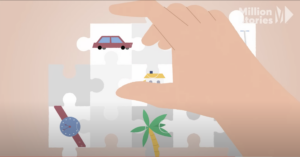Financial independence is the goal of having enough money to cover your living expenses without relying solely on a salary. This allows you to make choices based on what you want to do, not what you have to do. As financial expert Paula Pant puts it:
“Financial independence is the state in which your potential passive income, typically through investments, is enough that you could make decisions from a place of hope and desire, rather than fear or obligation.”
Here’s a three-step plan to achieve financial independence based on this advice.
Step 1: Grow the Gap
The first step is to grow the gap between what you earn and what you spend. Here’s how:
– Increase Your Income: Look for ways to make more money. This could be asking for a raise, starting a home business, or investing in higher education to get a better-paying job. The more you earn, the bigger the gap you can create.
– Cut Your Expenses: Be mindful of your spending. Identify areas where you can cut back without sacrificing your quality of life. For example, this can include cooking at home instead of eating out, canceling subscriptions you don’t use, or finding cheaper alternatives for everyday items.
Step 2: Invest the Gap
Once you have a surplus, it’s time to invest the gap. This means putting your extra money to work so it can grow over time. Here’s how:
– Learn About Investments: Educate yourself on different ways to invest, like passive investing or day trading. Understanding these options will help you make smarter decisions with your money.
– Diversify Your Investments: Don’t put all your money into one type of investment. Instead, consider investing in a diversified investment plan to reduce risk by spreading your investments across various asset classes. This way, if one investment doesn’t do well, others might still perform better.
– Think Long-Term: Investments tend to grow best when given space and time. Be patient and avoid trying to get rich quickly. Consistent, long-term investments are more likely to lead to a better financial situation in the future.
Step 3: Repeat
The final step is to repeat the process. Financial independence isn’t achieved overnight; it requires ongoing effort and building good financial habits. Here’s what to do:
– Regularly Check Your Finances: Keep an eye on your spending and savings. Adjust your financial behavior and manage your budget as needed to stay on track and ensure you are working towards your financial goals.
– Stay Disciplined: Consistency and regular investments are the keys to long-term growth. Keep your goals in mind, remind yourself of why you’re investing in the first place, and use this to drive better investment behavior over time.
– Embrace Uncertainty: Financial markets can be unpredictable. Avoid making investment decisions that are based on fear or reactions to market movements. These fluctuations can tempt you to make quick profits or “cut your losses”, but this prevents you from benefitting from the long-term performance of your investments.
Stay on Track
When all is said and done, achieving financial independence is about discipline and making smart choices with your money. By growing the gap between your income and expenses, investing wisely, and repeating this process consistently, you can build a more stable financial future.



